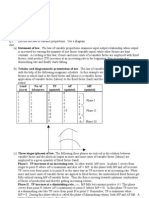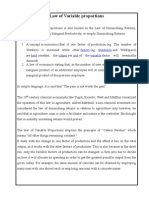Assignment On Consumer Behavior
Uploaded by
sujeet_kumar_nandan7984Assignment On Consumer Behavior
Uploaded by
sujeet_kumar_nandan79841
Assignment on Consumer Behavior
Submitted by:
Sujeet Kumar
MBA 1st Semester
Roll No. 25
Business Economics (114)
Sujeet Kumar MBA 1st Semester
Business Economics
2
ASSIGNMENT QUESTION:
State and explain the axiom behind the analysis of consumer’s behavior with suitable
example.
SOLUTION:
Consumers play an important role in determining the demand for a firm’s products.
They are quality conscious and price sensitive. The success of a product is
dependent on the consumer’s acceptance of the product. Price Sensitive customers
like to buy product in small quantities at affordable prices. For example, Indian
electronic products like computer CD, storage devices etc are available at high price
and better quality with service and warranty. On the other hand the same category of
product is available at more cheaper and affordable price in the Gray Market.
Therefore, firms must try to offer products that are of high quality, at affordable
prices. Consumer behavior is an important determinant of the type of product a firm
should produce. Before launching a product a firm has to take into consideration its
target customers tastes and preferences. For example, when Dabur Foods launched
Real orange juice, consumers rejected it because it tasted bitter. Research reveled
that Indian consumers wanted juices to be sweeter. Dabur then modified Real’s taste
by sweetening the orange juice.
Consumer behavior assumes that every individual tries to maximize his satisfaction
by consuming products and services with the limited income available to him at a
particular time. This limited income can also be referred to as the budget constraint.
In economics, consumer behavior theory explains the relationship between changes
in price and consumer demand. Variations in price determine whether a particular
product is in demand or not. If the demand for a product is low in spite of the price
being less, it can be said that consumers are not accepting that product. On the
other hand, if the demand for a particular product is high, then the price of the
product would increase. Hence the manufacturer can determine and fix prices of
their products according to the consumer demand. Thus, consumer behavior plays
an important role for manufacturer’s decision making.
Sujeet Kumar MBA 1st Semester
Business Economics
3
In more simple terms, “Consumer behavior is the process and activities where
people engage in the searching, selecting, purchase, using, evaluating and
disposal of products and services so as to satisfy their needs and desires.”
Axioms of Consumer Behavior:
• Existence of utility:
In economics, the term ‘utility’ is used to denote that quality of a commodity or
services by virtue of which our wants are satisfied. In other words, want
satisfying power of a good is called utility. This is assumed to be measured in
terms of cardinal numbers, such as 1,2,3,4 etc. These numbers are called
Utils or units of utility. Thus, 4 Utils of utility are greater than 3 utils of utility
and so on.
Thus, according to this axiom, utility is the function of satisfaction gained from
the consumption of goods or services. Numerically, it can be expressed as
U = f (x, y)
Where, X and Y are two different goods and x and y are quantity or number of
units of goods X and Y respectively.
E.g. Lets take two substitute goods. i.e. Tea and coffee, where when a
consumer consumes 1 cup of tea and 2 cup of coffee, he gets different level
of satisfaction. In this case, utility function can be shown as
U= f (T, C)
= f (1, 2)
• Law of Non-satiety:
The law of non satiety states that the consumer’s satisfaction is immeasurable
and it also focus on the assumption that consumers are not satisfied whether
whatever the number of utils he/she consumes.
The above statement can be expressed numerically as:
MUx = du / dx > 0
Sujeet Kumar MBA 1st Semester
Business Economics
4
Where, MUx represents Marginal utility of goods X
du / dx represent change in the utils of x.
in the above equation, it represents that, the MU of goods X cant be Zero or it
should be greater than Zero i.e. positive. This is also known as 1st order
derivative.
E.g. when a hungry man have one piece of bread he gets certain satisfaction
and he will get more or less some level of satisfaction with each unit of further
additional consumption.
• Law of Diminishing Marginal Utility:
The law of diminishing marginal utility states that as more and more standard
units of a commodity are continuously consumed, marginal utility derived from
every additional unit must decline. Indeed, it is so very natural to happen in
respect of all goods and services. It is, therefore, called ‘Fundamental law of
Satisfaction’.
Marginal utility refers to additional utility on account of the consumption of an
additional unit of a commodity.
Where in the above Law standard unit of a commodity means a cup of tea,
not a spoon of tea; a glass of milk, not a drop of milk etc should be consumed
at a point of time.
The above law may be expressed numerically as,
{d (du / dx)} / dx < 0
Or, d2U / dx2 < 0
This signifies that Marginal Utility of commodity X should be less than 0 or
can’t be 0 i.e. it should always be negative. The above equation is also known
as 2nd order derivative.
For e.g. when we consume, two piece of chicken, we get an utils of 4 but
when we consume 6 piece of chicken the utils of 10 is measured. It signifies
that the Marginal utility declines but total utility increases.
Sujeet Kumar MBA 1st Semester
Business Economics
5
This can be shown below in a tabulated form:
Quantity Total Utility Marginal Utility Description
0 0 -
1 8 8 Initial Utility
2 14 6
3 18 4 Positive Utility
4 20 2
5 20 0 Zero Utility
6 18 -2 Negative Utility
Sujeet Kumar MBA 1st Semester
Business Economics
You might also like
- DOMINION (2014-15) - Complete TV Series and LEGION Movie - 720p BluRay x264100% (1)DOMINION (2014-15) - Complete TV Series and LEGION Movie - 720p BluRay x2642 pages
- Mount Kenya University Bed 1101: Introduction To Micro-Economics Cat I Name: Abdikadir Osman Edin REG - NO: BOP/2020/63138100% (1)Mount Kenya University Bed 1101: Introduction To Micro-Economics Cat I Name: Abdikadir Osman Edin REG - NO: BOP/2020/631385 pages
- Advantages of Each Source of Finance and Their DisadvantagesNo ratings yetAdvantages of Each Source of Finance and Their Disadvantages8 pages
- Explain Entrepreneurship and Discuss Its ImportanceNo ratings yetExplain Entrepreneurship and Discuss Its Importance3 pages
- Labor: Total Product Marginal Product Average ProductNo ratings yetLabor: Total Product Marginal Product Average Product2 pages
- Objectives/ Learning Outcomes: Demand AnalysisNo ratings yetObjectives/ Learning Outcomes: Demand Analysis15 pages
- Revenue Curves Under Perfect and Imperfect CompetitionNo ratings yetRevenue Curves Under Perfect and Imperfect Competition32 pages
- Lecture Notes - Chapter 5 - Identifying Customer NeedsNo ratings yetLecture Notes - Chapter 5 - Identifying Customer Needs14 pages
- Module-1 Entrepreneurship: A Perspective: IntrapreneurshipNo ratings yetModule-1 Entrepreneurship: A Perspective: Intrapreneurship164 pages
- Operations MGMT Lecture Note (Chapter 2) MLTNo ratings yetOperations MGMT Lecture Note (Chapter 2) MLT33 pages
- APJ Abdul Kalam Technological University CET Campus, Thiruvananthapuram Kerala - 695016 India Academic Audit Report 2015 - 2016No ratings yetAPJ Abdul Kalam Technological University CET Campus, Thiruvananthapuram Kerala - 695016 India Academic Audit Report 2015 - 20166 pages
- Approaches For Enterpreneurship DevelopmentNo ratings yetApproaches For Enterpreneurship Development3 pages
- Notes: Unit 3 - Measurement and Scaling TechniquesNo ratings yetNotes: Unit 3 - Measurement and Scaling Techniques26 pages
- 10 Qualities of A Successful EntrepreneurNo ratings yet10 Qualities of A Successful Entrepreneur3 pages
- Chapter 1: Exploring The World of Business and EconomicsNo ratings yetChapter 1: Exploring The World of Business and Economics7 pages
- Capital Structure Decisions in Financial ManagementNo ratings yetCapital Structure Decisions in Financial Management52 pages
- Unit.1 Operations Research Notes (By Dr. Ksrinivas)No ratings yetUnit.1 Operations Research Notes (By Dr. Ksrinivas)21 pages
- Chapter 11 - Short-Run Technology ConstraintNo ratings yetChapter 11 - Short-Run Technology Constraint2 pages
- Chapter 1 - Introduction To Business EthicsNo ratings yetChapter 1 - Introduction To Business Ethics15 pages
- Quantitative Techniques: Linear Programming Problem - FormulationNo ratings yetQuantitative Techniques: Linear Programming Problem - Formulation43 pages
- Study Unit 4.1: The Theory of Demand: The Utility ApproachNo ratings yetStudy Unit 4.1: The Theory of Demand: The Utility Approach35 pages
- Financial Management: Operating Leverage & Financial LeverageNo ratings yetFinancial Management: Operating Leverage & Financial Leverage70 pages
- ACCOUNTING EQUATION, JOURNAL LEDGER - Solution100% (1)ACCOUNTING EQUATION, JOURNAL LEDGER - Solution4 pages
- Indifference Curve Analysis and Demand Curve83% (6)Indifference Curve Analysis and Demand Curve4 pages
- Institute of Postgraduate Studies Universiti Sains Malaysia Verification Form For Draft Thesis SubmissionNo ratings yetInstitute of Postgraduate Studies Universiti Sains Malaysia Verification Form For Draft Thesis Submission5 pages
- Personal Ethical Development: Lecture NotesNo ratings yetPersonal Ethical Development: Lecture Notes39 pages
- Gurugram Bus Station: NCR Bus Time Schedule & Line MapNo ratings yetGurugram Bus Station: NCR Bus Time Schedule & Line Map7 pages
- Declaration of Heirship and Sale - EnclonarNo ratings yetDeclaration of Heirship and Sale - Enclonar2 pages
- Module 03 Data Analytics Accessible PowerPoint PresentationNo ratings yetModule 03 Data Analytics Accessible PowerPoint Presentation71 pages
- An4635 Minimization of Power Consumption Using Lpuart For stm32 Microcontrollers StmicroelectronicsNo ratings yetAn4635 Minimization of Power Consumption Using Lpuart For stm32 Microcontrollers Stmicroelectronics52 pages
- Metals and The Reactivity Series CIE iGCSE 0620 PPQNo ratings yetMetals and The Reactivity Series CIE iGCSE 0620 PPQ14 pages
- NOVEMBER-26_CURFEW-HOURS_THESIS-ANISLAG-EDITEDNo ratings yetNOVEMBER-26_CURFEW-HOURS_THESIS-ANISLAG-EDITED10 pages
- Once A Hare Was Roaming Near A Lake in A ForestNo ratings yetOnce A Hare Was Roaming Near A Lake in A Forest15 pages
- DOMINION (2014-15) - Complete TV Series and LEGION Movie - 720p BluRay x264DOMINION (2014-15) - Complete TV Series and LEGION Movie - 720p BluRay x264
- Mount Kenya University Bed 1101: Introduction To Micro-Economics Cat I Name: Abdikadir Osman Edin REG - NO: BOP/2020/63138Mount Kenya University Bed 1101: Introduction To Micro-Economics Cat I Name: Abdikadir Osman Edin REG - NO: BOP/2020/63138
- Advantages of Each Source of Finance and Their DisadvantagesAdvantages of Each Source of Finance and Their Disadvantages
- Explain Entrepreneurship and Discuss Its ImportanceExplain Entrepreneurship and Discuss Its Importance
- Labor: Total Product Marginal Product Average ProductLabor: Total Product Marginal Product Average Product
- Revenue Curves Under Perfect and Imperfect CompetitionRevenue Curves Under Perfect and Imperfect Competition
- Lecture Notes - Chapter 5 - Identifying Customer NeedsLecture Notes - Chapter 5 - Identifying Customer Needs
- Module-1 Entrepreneurship: A Perspective: IntrapreneurshipModule-1 Entrepreneurship: A Perspective: Intrapreneurship
- APJ Abdul Kalam Technological University CET Campus, Thiruvananthapuram Kerala - 695016 India Academic Audit Report 2015 - 2016APJ Abdul Kalam Technological University CET Campus, Thiruvananthapuram Kerala - 695016 India Academic Audit Report 2015 - 2016
- Notes: Unit 3 - Measurement and Scaling TechniquesNotes: Unit 3 - Measurement and Scaling Techniques
- Chapter 1: Exploring The World of Business and EconomicsChapter 1: Exploring The World of Business and Economics
- Capital Structure Decisions in Financial ManagementCapital Structure Decisions in Financial Management
- Unit.1 Operations Research Notes (By Dr. Ksrinivas)Unit.1 Operations Research Notes (By Dr. Ksrinivas)
- Quantitative Techniques: Linear Programming Problem - FormulationQuantitative Techniques: Linear Programming Problem - Formulation
- Study Unit 4.1: The Theory of Demand: The Utility ApproachStudy Unit 4.1: The Theory of Demand: The Utility Approach
- Financial Management: Operating Leverage & Financial LeverageFinancial Management: Operating Leverage & Financial Leverage
- Institute of Postgraduate Studies Universiti Sains Malaysia Verification Form For Draft Thesis SubmissionInstitute of Postgraduate Studies Universiti Sains Malaysia Verification Form For Draft Thesis Submission
- Gurugram Bus Station: NCR Bus Time Schedule & Line MapGurugram Bus Station: NCR Bus Time Schedule & Line Map
- Module 03 Data Analytics Accessible PowerPoint PresentationModule 03 Data Analytics Accessible PowerPoint Presentation
- An4635 Minimization of Power Consumption Using Lpuart For stm32 Microcontrollers StmicroelectronicsAn4635 Minimization of Power Consumption Using Lpuart For stm32 Microcontrollers Stmicroelectronics
- Metals and The Reactivity Series CIE iGCSE 0620 PPQMetals and The Reactivity Series CIE iGCSE 0620 PPQ

































































































